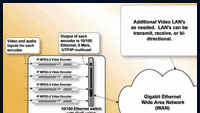Video over IP
The term ‘video over IP’ is used for many applications. Using MPEG compression, video over IP has been used for years in private network applications such as videoconferencing and surveillance. Its primary use in broadcasting has been for non-real-time transfer of video files over private networks or over the Internet.

Figure 1. Illustrated here is an example of high-quality, multichannel video operating over an IP network.
Broadcasters are now considering video over IP for real-time video uses such as program distribution, monitoring and video transport during program production for dailies, and clip approval. Video over IP is being planned for real-time transmission from OB vans and other remote sites, including transcontinental and global links.
Using video over IP offers broadcasters several benefits. These include a growing installed base of IP networks; low operating costs versus other transport methods; ease of use, such as file transfers over the Internet or real-time circuit setup; and changes in the operational model of broadcasting to all-digital distribution.
The two major concerns moving forward with video over IP are non-real-time transfer speed for large video files over IP networks, and reliability and quality of real-time transmission of video over IP.
The most prevalent use of video over IP in broadcast is for non-real-time transfer — store and forward of stored video data files such as short commercial clips and remotely gathered news. This does not require a high-bandwidth connection, but it sometimes suffers from the length of time to transfer large video files over the Internet or private networks.
Store-and-forward products provide real-time MPEG encoding — usually MPEG-2 — with the resulting MPEG file being stored on the encoding device. From the encoder, the captured files are then sent over IP to designated receive sites for playout or storage. File transfers can be to private or public FTP sites for retrieval by the receiving party, or they can be sent directly to a recipient, just like e-mail attachments.
Get the TV Tech Newsletter
The professional video industry's #1 source for news, trends and product and tech information. Sign up below.
The next step in the evolution of video over IP for broadcasters is real-time transmission of program content. Other types of digital networks, such as ATM and digital telephony circuits, have been used with good results insofar as transmission integrity and video quality.
Some constraints of using telephony circuits are cost and the fact that they are for point-to-point transmission only, unless used with large hardware switching arrays. ATM provides good circuit integrity for the continuous bandwidth requirements of real-time video, and it has multipoint capabilities. It has, however, been expensive to provision, and availability is minimal. This raises the demand for IP networks to carry real-time video. They are less expensive and can broadcast or multi-cast video streams.
Telecom service providers are beginning to offer IP connectivity at bandwidths high enough for broadcast services. 6Mb/s or more is desirable for program distribution, and 10Mb/s or more is desirable for contribution circuits that back-haul program material to a central studio.
A concern of using IP networks for program distribution or collection is the integrity of the IP connection, especially in multi-use networks where other, non-video traffic is present. IP network protocols allow data collisions that can destroy or delay transmission of data packets. This is tolerable for bursty computer data or most Internet traffic because it can be re-transmitted. It can, however, cause problems for video transmission, which requires a continuous flow of data, without re-transmission.
Manufacturers of real-time IP video equipment have made product enhancements to minimize such effects, and advancements in IP networking with QoS is promising. Effective QoS policies on IP networks will be a factor in their use for video program distribution, although IP networks dedicated to video traffic, but without QoS, are more tolerant of continuous video traffic, and multiple video channels have been successfully transmitted in mission-critical applications. Figure 1 on page 10 shows an example of high-quality, multichannel video operating over an IP network.
Summary
The economic advantages and operational flexibility of video over IP are significant in broadcast operations. Non-real-time video file transfer over IP networks and the Internet is a popular technique. Using real-time MPEG video transmission for communications within a multi-site operation is increasing with the availability of IP networks, so video over IP for program distribution and contribution is the next step. Growth in this application will occur as broadcasters become confident that video integrity and quality can be maintained through QoS techniques and as more IP networks are dedicated to video transmission.
Another stimulus for video over IP is the emerging standards activities, such as MXF, to provide information wrappers around digital video payloads. While this does not strictly require an IP structure, it is expected to be the primary means of transport. Continued growth in broadband connectivity will also stimulate video over IP. Although slowed by recent economic conditions, it is expected that both public and private telecom companies will continue to expand their IP services. Indeed, there are many faces to video over IP, and definitions must become more precise as IP network uses grow in the broadcast industry.
Ken Regnier is product manager for Axon Digital Design.
